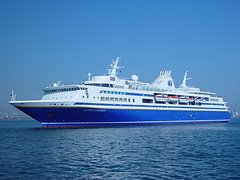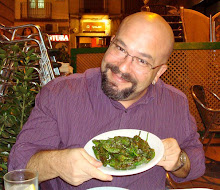I wanted to tell you about the boat people, that is, my fellow voyagers. My post is prompted by last night’s auction. This was a charitable event in which donated goods and services were auctioned to raise money for various charities in the ports we are visiting. The Kid, for example, auctioned off two Spanish lessons. Others donated their time-share week. There was a dress, and a nautical chart signed by the officers, as well as breakfast in bed served by the deans. This morning, Zoë, the Kid, some of the UVA grad students, and I sat around marveling at the prices that were paid. $1600 for a weekend in a Manhattan brownstone. $300 for the right to steer the ship for 15 minutes. $75 for the Kid’s Spanish lessons. Of course, it was all for charity, so you had to be happy that so much money was being raised, but we couldn’t help but be astonished by how much money there was to be spent. And these were not just the grownups bidding: the students were right in there. One student dropped over $2000 on two items.
So, when people tell you that S@S attracts a lot of rich kids, they’re right. There are students on here with apparently endless supplies of parental cash. There are also students who are on financial aid, or who have taken out loans, or are on work study. Often, these are the students that have the most interesting experiences. Since they can’t afford to fly off to Machu Picchu or San Pedro de Atacama, they have to make do with what’s in the port, or what’s nearby, and so they’re the ones who end up visiting poor neighborhoods, going on service visits, volunteering in orphanages, checking out local schools. Theirs is not a tourist trip, but an educational one. I wonder what would happen to the educational value of S@S if the program put a cap on how much students could spend in port?
But lest everyone believe that the S@S population can be understood purely in terms of a hierarchy of available wealth, I offer the following catalog of shipboard types, which I’ve collected over the course of the summer. The types are not always mutually exclusive, and I am painfully aware that my list is nowhere near exhaustive. Here it is:
- The Ingénue – Has never left the US. Began the trip absolutely innocent about what it might mean to travel abroad. Earnest, eager blank slate. “Quito”? What’s “Quito”? Happy to learn the answer to this and other questions.
- The Sophomoric Traveler – Already knows everything there is to know about travel and about the countries to be visited. Will gladly list the number of countries he/or she has visited, and will recount anecdotes at the drop of a hat. Anecdotes reveal little insight or wisdom.
- The Proud S@S Veteran – Begins every conversation about shipboard life with the phrase, “On my previous voyage…” and proceeds to speak in detail about what things were like then. These details are interesting to no one but the speaker.
- The Bonehead – Dude, I got so wasted in Guayaquil! Can’t wait to go skiing in Chile! What, you mean there’s a paper due today?! Bummer . . .
- The Earnest Youth – Like the ingénue, but much better informed. Extremely respectful of other cultures, almost to a fault. Getting his or her Peace Corp application ready to be mailed upon docking in San Diego.
- The Underpaid Staff Member – 350 copies by tomorrow? How much are you paying me to do this? I thought I was going on a free trip!
- The Glorified Tourist – Immune to real learning. Eager to add jewels to his or her crown of touristic glory. Has forked over cash for Galapagós, Easter Island, Machu Picchu, and Tikal. Doesn’t care that this means not seeing much of Ecuador, Chile, Peru, or Guatemala.
- The Ship Kid – Let’s play hide-and-go-seek in the Union! When are they going to fill the pool again? Machu Picchu was awesome!
- The Ship Baby – Gurgle. Smile. Sleep. Gurgle some more.
- The Young Scholar – Speaks intelligently about his or her class work. Finds the much-debated core course valuable, and understands the connection between it and the port visits. Does the reading. Writes good papers. There are more of these than you might suspect.
- The Self-Righteous American – Can’t stand the leftist bias of the professors. Believes that laws in foreign countries are only suggestions from which he is exempted when convenient.
- The Faculty/Staff Spouse – What do you mean I don’t have unlimited internet access? And is it really my turn to watch the kids again?
- The Sensitive American – I can’t believe my country has done such horrible things to these poor people! Oh! Look at those lovely ponchos . . . How much?
- The Amiable Retiree – Retirement home? I’d rather play dominoes on the MV Explorer. Wake me up when we get to port.
- The Debutante – Well, if the only way to get to Machu Picchu is on the super-first-class Hiram Bingham train for $500 round-trip, then I guess that’s what I’ll have to pay. Know any good hotels in Acapulco?
- The Hippie – Yes, they’re on the ship as well! They have not seemed to notice the little bottles of shampoo and conditioner in their cabin bathroom.
- The Frazzled Professor – No weekend? When am I supposed to grade all these freakin’ papers? Who assigned them?!?! Oh, yeah … I guess I’ll just throw up my hands and blog …






